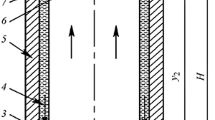Abstract.
Closed-loop thermosyphons are systems in which heat is transferred from a source to a sink by means of a natural convective flow, i.e. without the help of mechanical pumping. In fact, the dynamics of such systems strongly depend both on the thermal boundary conditions and on the gravitational field in which they operate. While the effect of variations of the boundary conditions has been extensively analysed in the last decades, the dependence on gravity has never been explicitly studied.
The aim of this paper is to examine the effect of variations of gravity as well as that of thermal boundary conditions on the dynamics of natural circulation loops. Such an analysis might point out some useful applications for the cooling of a generic source in reduced gravity conditions.
To this purpose an experimental campaign was performed on a natural circulation operating under a gravity field varying in the range between 10–2 g and 1.8 g, with g = 9.81 ms–2. The dynamical behaviour detected during the experiment was used for the validation of a mathematical model, previously validated under terrestrial gravity conditions. Model simulations were found to satisfactorily reproduce the dynamics of the system under variable gravity. This proved the possibility to use the model for the construction of bifurcation diagrams describing the behaviours of natural circulation loops under variations of both the gravitational field and the thermal boundaries.












Similar content being viewed by others
References
Vijayan PK; Nayak AK; Pilkhwal DS; Saha D; Venkat Raj V (1992) Effect of loop diameter on the stability of single-phase natural circulation in rectangular loops. Proc 5th Int Topical Meeting on Reactor Thermal Hydraulics (NURETH-5), Salt Lake City, USA, 1: 261–267
Greif R; Zvirin Y; Mertol A (1979) The transient and stability behavior of a natural convention loop. Trans ASME 101: 684–688
Welander P (1992) On the oscillatory instability of a differentially heated fluid loop. J Fluid Mech 29-1: 17–30
Wang Y; Singer J; Bau HH (1992) Controlling chaos in a thermal convection loop. J Fluid Mech 37: 479–498
Singer J; Wang Y; Bau HH (1991) Controlling a chaotic system. Phys Rev Lett 66-9: 123–1125
Sen M; Ramos E; Trevino C (1985) The toroidal thermosyphon with known heat flux. Int J Heat Mass Transfer 28-1: 219–233
Sen M; Ramos E; Trevino C; Salazar O (1987) A one-dimensional model of a thermosyphon with known wall temperature. Int J Heat Fluid Flow 8-3: 171–181
IV Student Parabolic Flight Campaign, web-site: http://www.estec.esa.nl/outreach/parabollic/index.html
Cammarata L; Desrayaud G; Fichera A; Pagano A (2002) Experimental validation of a model-based controller for a rectangular natural circulation loop. Proc12th Int Heat Transfer Conference, Grenoble, France
Rodriguez-Bernal A; Van Vleck E (1998) Diffusion induced chaos in a closed loop thermosyphon. SIAM J Appl Math 58-4: 1072–1093
Fichera A; Pagano A (2003) Modelling and control of rectangular natural circulation loops. Int J Heat Mass Transfer 46: 2425–2444
Gorman M; Widman PJ; Robbins KA (1986) Nonlinear dynamics of a convection loop: a quantitative comparison of experiment with theory. Physica 19D: 255–267
Strogatz SH (1998) Nonlinear dynamics and chaos. Perseus Books, Cambridge, Massachusetts
Acknowledgements.
The present work was supported by a grant of the ASI (Italian Space Agency). The authors whish to thank the students Michele Aiello, Roberto Conti, Giampiero Evola, and Giacomo Timpanaro for their assistance during the experimental campaign.
Author information
Authors and Affiliations
Corresponding author
Rights and permissions
About this article
Cite this article
Cammarata, L., Fichera, A., Guglielmino, I.D. et al. On the effect of gravity on the bifurcation of rectangular closed-loop thermosyphon. Heat Mass Transfer 40, 801–808 (2004). https://doi.org/10.1007/s00231-003-0480-6
Received:
Published:
Issue Date:
DOI: https://doi.org/10.1007/s00231-003-0480-6




